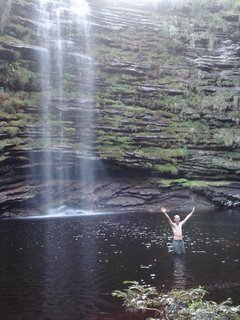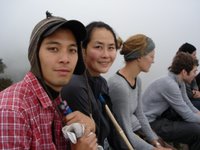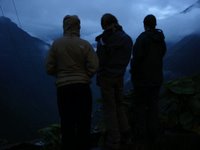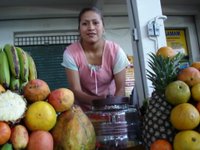
Okay, we're in Argentina, and I've got some things I want to write about now, but there are some last thoughts on Brazil that I wanted to get in.
Favela Tours
So after some debate, Simon and I decided to take a guided tour of a favela, slum towns on the hills surrounding Rio. (It`s funny, in Rio, the rich live at sea level close to the beach and the poor live in the hills with amazing views of the beach.) I am sure many of you are appalled by the idea. And you should be; it seems completely jacked up to bring tourists in to view the blight and poverty of a city in such a voyeuristic way. But the more that I thought about it, the economist in me realized that everyone is probably better off with the tour in existience. We, as a travelers, have a better sense of what life is like in Rio, rather than staying on the ritzy beach in Ipanema drinking coconut juice and working on our tans. Aand the favelas are better off, since a portion of the fee goes towards community projects. I was not entirely comfortable with the idea, but I thought I would be less comfortable with the thought of turning a blind eye to it. It also had gotten some pretty amazing reviews from fellow travellers so we went for it.
We went with a guide named Luis, who owns a company called Be A Local, and has run tours in the favela for three years. On the main road, the favelas were actually much more built up that I expected. For some reason, I expected shanty towns and clapboard houses, as many people said that the communities aren't really recognized by the government. However, for the record, there is a post office, a health clinic, schools and community workers picking up trash, or at least in the particular favela we were in (though none of these services are enough to support the favela´s population - about 200,000 people). Instead of corrugated metal and wood, I found all the houses were made of brick and most had more than one floor. There were also tons of stores , including bars, bakeries, grocery stores etc. That being said, the conditions, especially as you got further away from the main road, were pretty squalid. Open sewers and garbage everywhere.
Tons of "regular" people live in the favela, including a lot of blue collar workers such as waiters, housekeepers, etc and all the people that keep Rio working. Not surprisingly gangs and drug dealers control a lot of what goes on there. I´m sure Luis sends a cut of our fee to the local dealer. And while Luis pointed out some drug dealers that were keeping watch (so we don`t take pictures of them), it felt pretty safe in the favela with the guide.
What was more interesting than the favelas themselves is seeing how Luis interacted with the members of the community. His company, among other things, created a free day care program which houses 60 kids in the community. He is obviously concerned about the kids in the community, but gives them a lot of tough love. He told the kids that he did not want to see them begging tourists for money. If they wanted money, they would have to do something for it. So with the help of favela artists, the kids paint make small paintings, bracelets and necklaces to sell. He told us that we should only buy them if we wanted them and not because we were motivated by guilt. He also insisted that under no circumstances should we buy if we are approached by kids trying to hard sell some of their crafts. And whenever a child did it, he said he has punished them by not bringing his tour groups by for a week. He felt they would not be learning anything from simply getting handouts and/or trying to guilt people into buying things. Tough love. I really admire what he is trying to do, and I can`t imagine how many lines he has to draw in a given day.
It´s a tough situation, and definitely not all black and white and I am glad I did it.

Churrascaria
Okay, in a terrible juxtaposition from the favela tour, the night before going into a favela we went to a traditional Brazillian Churrascaria. Basically, it´s an all-you-can eat restaurant with buffet tables of salad and sushi and waiters bringing racks of grilled meat right to your table. You get these little buttons with one side in green that says "sí" and the other side in red saying "no." If you don't want to get any more meat, you turn your button over so the waiters know not to come by. However, it seemed that the waiters kept disrespecting Simon's red button for some reason and kept piling on the meat. The food was pretty good and I was really excited for the sushi, which was just ok by any American standard, but welcome since I was totally craving rice. I had to stop after maybe a plate and half of meat (it's hard to count since it just keeps coming). As Simon said, you don´t want it to be a bad experience. We went with four others in our hostel and had a blast. I think our entire meal, plus drinks ended up being about $15 USD each. I am glad I did it, but it has kind of turned me off of meat for a while. Good thing I'm in Argentina.
Franguese
Simon's talked about his thoughts on language and I should add my experience on this. I speak some french and toisanse, a variation of the cantonese dialect. I've used each once, and in only one of those occurences was it marginally helpful. The first was in a hostel where I brokered a shopping trip between and American girl and a French girl. The second was in Peru when we went to a cambio to exchange dollars and the owners were chinese and spoke toisanese (which by the way, is really rare, esp considering the husband was born in the jungle of peru). And it wasn't necessary, since they spoke spanish perfectly.
I took some crappy adult ed class in spanish before I left, and it didn't really help all that much. But to be honest, I don't thinkI could have handled anything more intensive given work and packing up and the like. If I know the context, I think I can understand the gist of what is going on. And one out of three times, the word in french is same as the one in spanish, so I find myself using french a lot. It's a terrible habit.
But when Simon caught some kind of bug in Itacare, I had to buy a thermonter to measure his temperature. The best I could muster was "Mi esposo tiene un febre. Quiero se cuantos celcius." Downright miserable I know. The pharmacists (I had to go to several before I found one which carried thermonters) were utterly confused. When they figured it out, I was totally confused, because they started sticking pens and things into their armpit and shaking their head. I didn't realize that you stick the thermonter in your armpit and not in your mouth in this country . I felt like an ignorant american in Brazil, in particular. I figured, I need to focus on one language right now and I think Spanish is the one.
But I also find that I get nervous speaking Spanish and sometimes I will really think about something and put off asking a question, for lack of confidence. For instance, I just wanted to know what neighborhood our hostel was in, but I spent about five minutes rehearsing the question "Donde esta el hostal en Buenos Aires?" in my head before asking it. It's the same nervousness I get when I try to talk to someone else (other than family members) in chinese. I just need to be more agressive about speaking more. Hablo castellano bonito un dia.
Five Reasons I Am Excited About Argentina
1. Tap water - you can drink it here, so I can drink to my hearts content
2. Ice cream and butter - the dairy is amazing in this country
3. Pesos - the exchange is great due to a weak peso and we can eat out again for about $2-4 each.
4. No mosquitos (or at least in BA)
5. Salads - related to the water issue. I know I can eat as many salads as possible.




















